Influencer marketing has become a must-have strategy for brands, and for good reason. From viral TikToks to trusted product reviews on Instagram, today’s consumers are discovering what to buy from the people they follow, not just traditional ads.
But standing out takes more than just sending a freebie and hoping for the best. The smartest brands are building strategic partnerships with creators that are aligned with business goals and backed by data.
In this guide, we’re looking at how leading retailers are working with social media influencers and breaking down how to find the right creators for your brand. But first, let’s get into why influencer marketing works.
Why Influencer Marketing Works for Retail
How often do you see a creator you follow recommend a new brand? Or find yourself scrolling through TikTok or Instagram for product reviews? Maybe you’ve even snagged a deal using an influencer’s affiliate code. These moments aren’t random. They’re all ways influencers can help retail brands at every step of the customer journey.
Influencers build awareness by introducing products to audiences who might not find them otherwise. Hearing about a brand from a real person that you trust or admire makes it feel worth checking out. In fact, 60% of Gen Z shoppers discover new products or brands on social media.
But it doesn’t stop there. When people research a potential purchase, influencer posts become trusted resources. One survey found that 82% of internet users worldwide use social media to research products they are interested in buying. Authentic reviews, demos, and comparisons from creators all provide the kind of social proof consumers crave.
Influencers also play a role in driving purchases. Nearly three out of four shoppers say they’ve bought something based on an influencer recommendation. It’s no surprise, then, that influencer and creator-driven revenues have shot up by 20% from last year to a projected $184.9 billion in 2025.
At the heart of it all is trust. Seeing a real person back a product is far more persuasive than any traditional ad, making it a game-changing strategy that no retail brand can afford to ignore.
Real-World Success: How Top Retail Brands Use Influencers
Now that we’ve established why influencer marketing works, let’s take a look at how. Several household retail brands have effectively tapped into the power of influencers, with their campaigns far exceeding industry benchmarks for engagement.
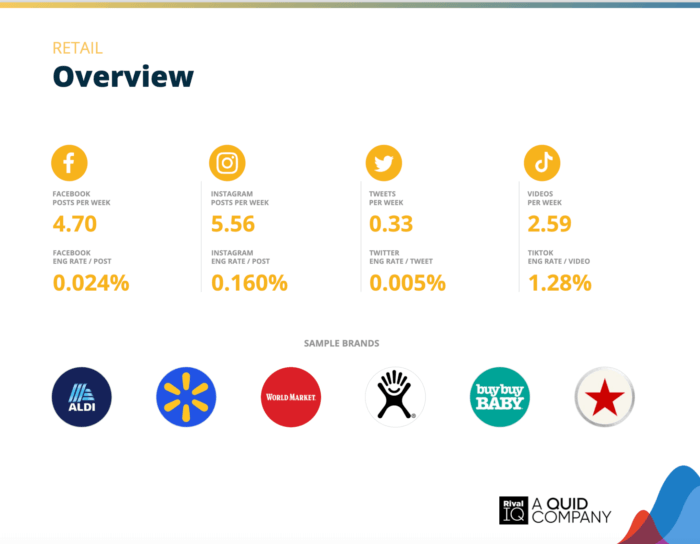
From Walmart to Amazon, here’s how top retail brands are using influencers and what you can learn from their approaches.
Walmart Gives Back With A “Random Acts of Kindness” Influencer
Jimmy Darts is a massive presence on social media, with over 12.3M followers on TikTok alone. Known for his random acts of kindness videos, the influencer regularly approaches unassuming strangers and offers them a gift, ranging from straight-up cash to free meals and trips.
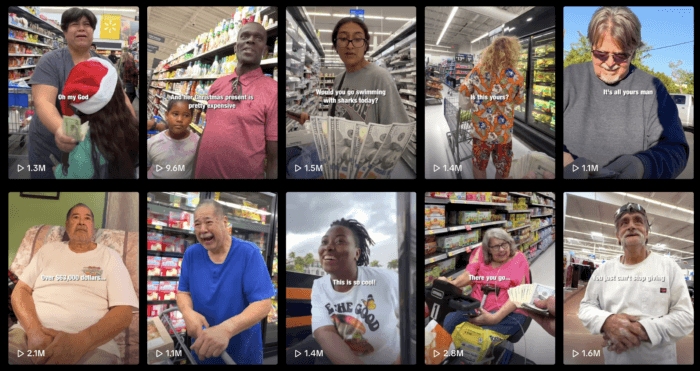
Often, these moments unfold in everyday places — including the aisles of a supermarket. It seemed natural, then, for Walmart to team up with the creator during the holiday season, with the retail giant helping him “spread toy joy” to kids.
In one especially moving TikTok, Jimmy gifts a shopping cart full of toys to Estella, a child with leukemia, who would then go on to share them with other kids at her clinic. The video struck a chord with viewers, earning more than 700K likes for a 46.1% engagement rate by follower. That’s 36x higher than the industry median.
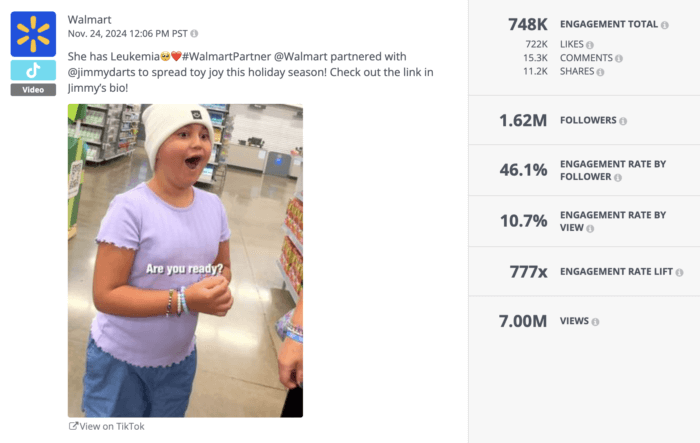
Another post took a more playful approach, featuring a family racing to grab as many toys as they could in 30 seconds, which Jimmy then gifted to them. That TikTok earned a still-impressive 8.91% engagement rate, or nearly 7x the median.
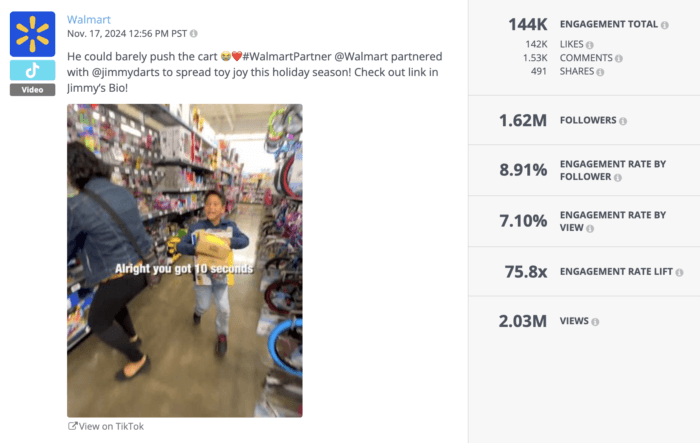
What makes this collaboration so effective is how naturally they fit into Jimmy’s existing content. This campaign didn’t feel like an in-your-face ad but like a continuation of the creator’s mission, just with Walmart quietly behind the scenes. For followers used to seeing him in stores, the retailer’s involvement felt organic.
Other retail brands can take a cue from this approach. Instead of forcing a brand message into unfamiliar territory, look for creators whose content already aligns with your values, products, or environments. The right fit makes all the difference and keeps your message feeling genuine.
Target Shows Love To A Big Fan
Sometimes, the best influencer partnerships don’t come with a pitch deck or a contract. They start with noticing a genuine moment and turning it into something special.
That’s exactly what Target did when they spotted a viral video from lifestyle influencer Addie McCracken that featured her son, Rustyn. In the clip, Rustyn gushes over his love for Target, particularly the vacuum aisle.
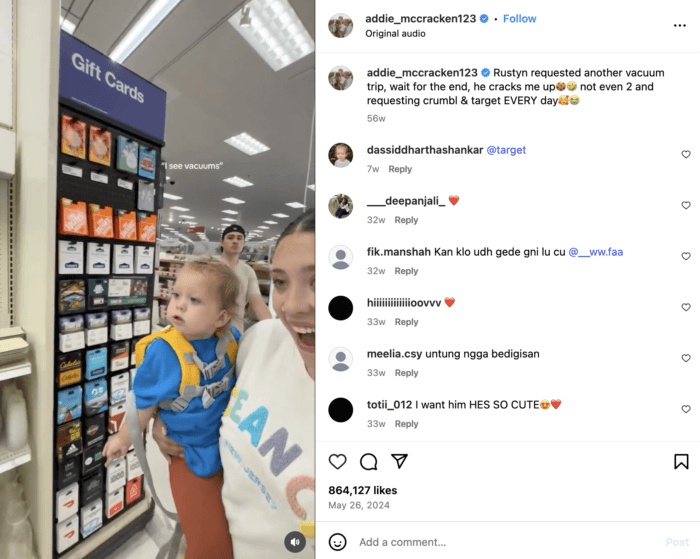
Rather than letting the moment pass, Target leaned in. The retail brand coordinated with a local store to give Rustyn his own mini-vacuums. The resulting Instagram post racked up a staggering 1.32 million engagements, with a 45.5% engagement rate that shot way past the industry median of 0.16%.
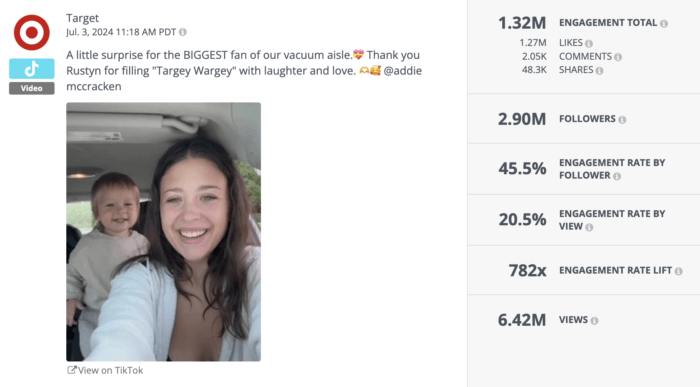
A few months later, the retailer gifted Rustyn a Bullseye mascot costume and teamed up with Addie again to promote their Halloween costume collection. The TikTok earned a 52.3% engagement rate, making it Target’s most engaging post of the past year.
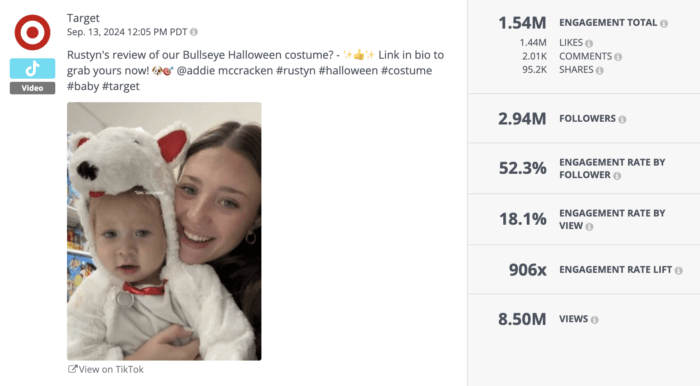
What makes this partnership so notable is that it happened organically. Rustyn was already a fan, and the brand simply leaned into that genuine excitement. It’s a reminder that some of the best influencer relationships begin by listening. Watch for creators who already love your brand, and you might just find the perfect opportunity to spark a heartfelt and high-performing connection.
Sam’s Club Puts Its Products To Work
Another smart influencer move? Letting creators actually use your products — and having the results speak for themselves. That’s exactly what Sam’s Club did with baker and creator Mackenzie Lee (@itsmacksmacs), who’s built a loyal following of 1.3M followers on TikTok.
Noticing that Mackenzie was already using Member’s Mark ingredients in her videos, Sam’s Club teamed up with her for a feel-good holiday collaboration: baking holiday cupcakes for a local food bank. The video struck the perfect balance of inspiring and practical, earning 366K views and a 22.3% engagement rate by follower that’s well above industry benchmarks.
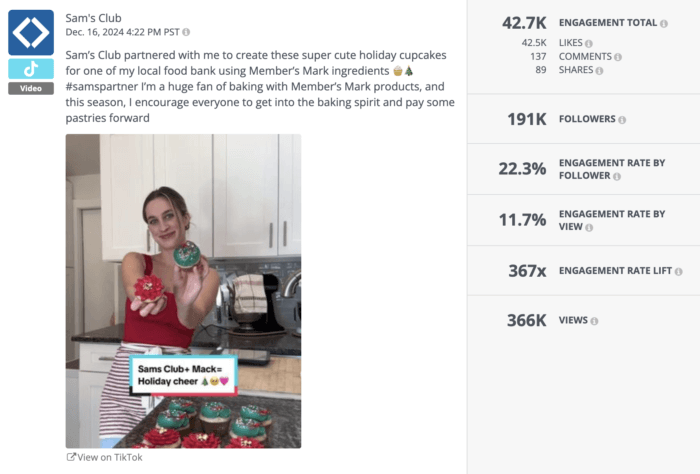
This is a great example of how retail brands can benefit from putting their products to work through influencers who already have the skills (and the audience) to tell that story. Rather than simply pushing a product, Mackenzie was the perfect creator to show it in action.
Amazon Shares Influencer Recommendations
For e-commerce retailers, influencer marketing can quickly lead to sales through accessible links. Amazon smartly leaned into this angle by making it easy for audiences to shop influencer picks with just a few clicks.
Take their partnership with influencer Paige Desorbo to promote Prime Big Deal Days. Paige curated a selection of her favorite fall refresh items and shared them with her followers. Each product recommendation could be accessed in a link in both Amazon’s and Paige’s bio, making it seamless for users to browse and buy.
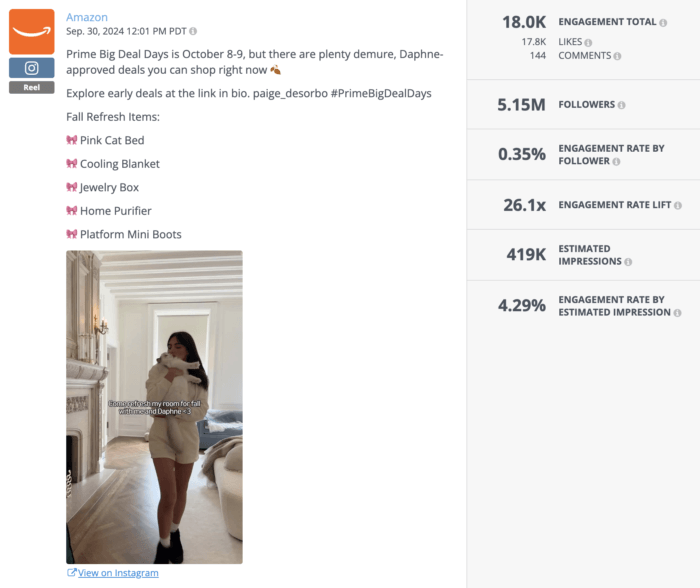
Having influencer storefronts is another genius aspect of Amazon’s influencer marketing strategy. These personalized shopping pages let creators feature their favorite picks, organize them by category, and continuously update with new finds. For followers, it’s like shopping from a trusted friend’s recommendations. For brands, it’s a way to keep product recommendations live and converting, long after the post is published.
The takeaway for e-commerce retailers? Give influencers the tools to make shopping frictionless. That way, you’re not only building awareness but converting.
Finding the Right Influencers for Your Retail Brand
A big lesson to pick out from the above examples is that choosing the right influencer goes beyond follower count. What really matters is alignment and finding creators who reflect your brand’s voice, values, and audience.
Look for influencers whose followers align with your target shoppers and whose content feels like a natural fit for your products. For example, a beauty brand focused on clean, sustainable makeup might partner with a micro-influencer who regularly shares eco-conscious tutorials. This kind of niche alignment helps you reach audiences already primed to engage and buy.
Pay close attention to the influencer’s engagement. Consistent likes, comments, and authentic conversations are signs of a loyal community that trusts the creator’s recommendations. Micro- and nano-influencers, in particular, can drive powerful results thanks to their close-knit, highly engaged audiences.
To make influencer discovery easier, use tools built for smart social search. For instance, with Rival IQ’s Discover feature, you can explore Twitter and Instagram by topic, hashtag, or keyword to quickly find relevant creators, uncover new trends, and even spot high-performing content. It takes the heavy lifting out of research so you can spend less time digging and more time building lasting relationships with the right influencers.
Measuring What Matters: KPIs for Influencer Campaigns
The work doesn’t stop once your influencer campaign is live. You also need to measure its impact. The right KPIs will depend on your goals, but common metrics include reach, engagement, click-through rates, and conversions. Tools like UTM parameters or coupon codes can help pinpoint which creators are actually driving revenue, while sentiment analysis offers insight into how audiences perceive your brand.
That said, tracking performance across multiple creators and platforms can get messy fast. That’s why many marketers rely on automation and influencer analytics tools. With all of your influencers tracked in Rival IQ, you can easily monitor campaign activity using filters for hashtags, mentions, and even URLs.
Auto-tagging rules and scheduled exports simplify your reporting, so you can quickly see who’s posting, how often, and what kind of results they’re driving. It’s a streamlined way to answer the big questions: Who’s performing best? What content is resonating? And how can you double down on what’s working?
With the right data at your fingertips, you’ll be in a better position to refine your influencer marketing strategy and drive lasting impact from your partnerships.
The Wrap Up
Influencer marketing works best when it’s built on authentic connections and backed by data. Whether you’re spotlighting products, supporting superfans, or driving direct sales, the key is knowing what’s resonating. With smart influencer tracking, retail brands can measure impact, optimize partnerships, and invest in what works.
